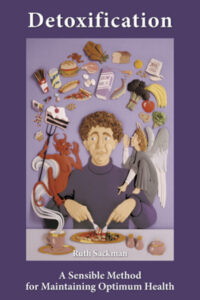Nutritional gurus wisely tell us to eat a wide variety of colors when it comes to fruits and vegetables. This insures that we get the full range of phytonutrients the plant world has to offer. However, perhaps you’ve noticed lately, there’s a whole lot more purple in the produce section amidst the usual greens, yellows and whites. We’re talking about more than the standard beets, eggplants, red cabbage and onions: purple-hued kale, cauliflower, carrots, asparagus, peppers, potatoes, even sweet corn, etc., etc.! And for good reason — turns out, deep red, blue and purple-colored foods contain perhaps the richest amount of a most potent micronutrient, the antioxidant anthocyanin, which research is finding to be especially beneficial for cancer prevention, heart and gut health, dementia, osteoporosis, insulin resistance and more.
Anthocyanins — Antioxidants Par Excellence!
Phytochemicals are micronutrients in plants with potential to enhance health and fight disease. Polyphenols, one class of phytochemical, are packed with antioxidants which play a key role in preventing damage to cells that can lead to serious disease. Flavonoids are types of polyphenolic molecules with particularly strong antioxidant activity. Anthocyanins are a type of flavonoid. They are the pigments that give deep red, blue and purple plants their rich coloring. All fruits, vegetables, herbs and spices contain antioxidants, but studies are showing that plants with purple predominating indicates a whole lot more anthocyanin, i.e., stronger antioxidants in greater density than found in other colors of produce. In other words, Nature is tipping us off to the fact that the more purplish the color, the more powerful the antioxidant effects of reducing inflammation and protecting DNA.
Purple potatoes have 4 times as many antioxidants as Russet potatoes. Compared to orange carrots, purple carrots have 2 times the amount of alpha and beta carotene which the body converts to Vitamin A, a key antioxidant that enhances immunity and eye health. Red cabbage contains 36 different types of antioxidants and 6 – 8 times more Vitamin C than green cabbage. Clearly, the message is that, hey, purple foods are very much worth including in our daily fare! This is not to the exclusion of a mix of other colors, but certainly purple deserves a front row seat at the table!
Some Benefits of Anthocyanin
While it is not currently known exactly what it is about purple pigments that makes them so powerful, there is little doubt that the power is there. So what is it that a preponderance of anthocyanins can do? Here are some avenues of study:
Anti-Inflammatory.
Anthocyanin reduces inflammation. Chronic inflammation is one of the underlying causes of many of the diseases of modern times, including asthma, heart disease, Alzheimer’s, Type 2 diabetes, arthritis and joint disease, obesity, and certain cancers.
Heart Health.
Studies show that eating a high amount of anthocyanin improves many cardiovascular risk factors, such as the ability to lower artery rigidity, lower blood pressure, improve blood sugar metabolism, as well as fight oxidative stress, a process known to play a role in heart disease.
Cancer Prevention.
Anthocyanin has been associated with cancer prevention. One 2013 study in Molecular Nutrition & Food Research posits that purple sweet potato may protect against colorectal cancer — the third most common cancer. Purple corn, though difficult to find, was also found to have particularly strong cancer-combatting strength. One study concluded that purple corn showed significant blockage of colon cancer cells. Recent animal research with pigs discovered that purple potatoes lowered interleukin 6, a pro-inflammatory protein known to promote colon cancer — nearly 6 times more than the control pigs diet. A 2010 study in test-tube experiments found that anthocyanins extracted from blueberries helped inhibit the growth of breast cancer cells.
Brain Health.
A 2003 study in Archives of Pharmacy Research noted memory-enhancing effects of consuming purple sweet potatoes. Other studies indicate anthocyanin helps prevent age-related decline in the nervous system. Anthocyanins are also able to cross the blood-brain barrier and localize inside brain regions related to learning and memory.
Eating Purple
Nowadays breeders are busy cultivating more and more purplish varieties to make available more health-supporting anthocyanin! No wonder: currently, deep red/purple/blue foods make up only about 3% of the average American’s fruit and vegetable intake, so there’s lots of room for growth. Note: supplements for anthocyanin have not been tested for safety or quality assurance. It is always far better to get your nutrients from real (preferably organically-grown) food containing all the synergistic elements that Nature has provided — and which may not even be known by science — rather than isolating single nutrients in a pill.
Here is a partial (by no means exhaustive) list of rich red, blue and purple-colored fruits and vegetables loaded with antioxidant activity:
Beetroot, Blueberries, Eggplant, Fig, Purple Potato, Red Cabbage, Purple Cauliflower, Purple Asparagus, Blackberries, Purple Carrot, Acai Berries, Purple Corn, Cube (purple yam), Lavender, Red Grapes, Red Wine, Passion Fruit, Plum, Prunes, Raisins, Purple Pepper, Red Onion, Cherries, Purple Artichoke, Purple Kale, Purple Belgian Endive, Purple Broccoli, Purple Okra, Edible Violets, Red Leaf Lettuce, Purple Sweet Potatoes, Purple Pod Pole Beans, Pomegranates, Elderberries, Cranberries, Purple Olives, Rhubarb……
Bon Appetit!
Resources
“The Benefits of Anthocyanin” — verywellhealth.com
“Eat More Purple Foods for Cancer Prevention and a Healthier Heart and Gut” — Dr. Mercola
“Purple Vegetables — What Is So Special About Them?” — GrowTest.org
“10 Powerful Purple Plants You Should Be Eating and Why” — Food Revolution Network





